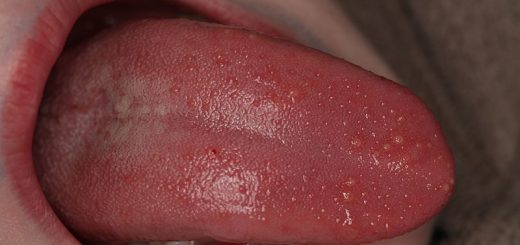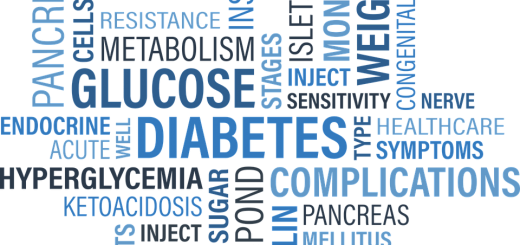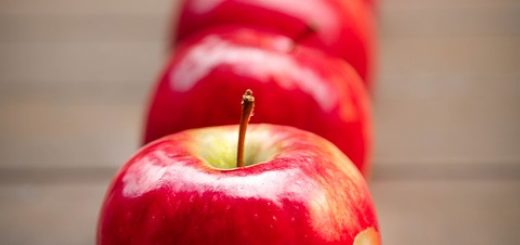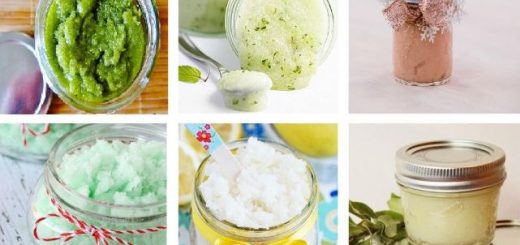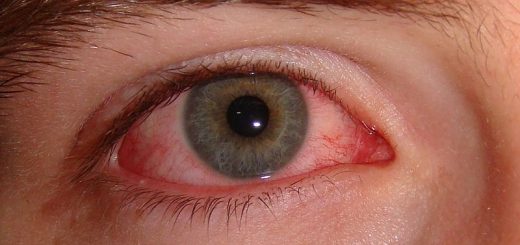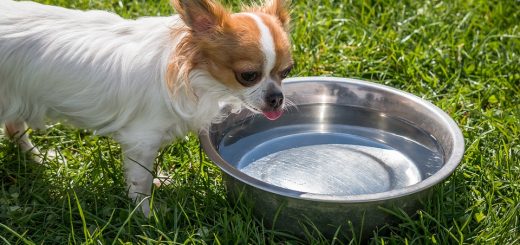24 Ways to Prevent Cataracts
A cataract is a type of vision problem. When a person gets cataracts, the colored parts of their eye (pupil and iris) will turn a grayish color, as though they have fogged over. This can make it difficult to see through the eye. This can impact all parts of the vision, including nearsightedness, farsightedness, and even night vision.
People may only have a cataract in one eye, or they may have it in both eyes. Much of the time, a person will usually end up having a surgery to fix the issue. Not to worry– the surgery has been used for decades and is totally safe.
Causes
Cataracts are usually seen in the elderly, as they most often come with aging. They can also happen as a result of an eye injury, a previous eye surgery, or another ailment that affected the eye in the past.
Sometimes, cataracts can be hereditary, meaning that they run in the family. They can also be a result of another ailment, like diabetes or an inherited eye problem.
Types of Cataracts
There are four main types of cataracts. Each type looks generally the same and has many of the symptoms listed above. However, the different types of cataracts may develop differently and affect the vision in different ways.
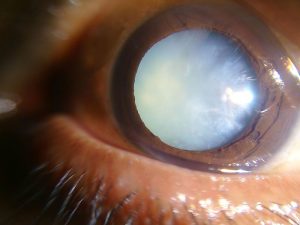
Advanced-stage cataract
Congenital Cataract
Sometimes people are born with cataracts, or they develop them when they are a young child. This is a rare form of cataract. For a child to be born with cataracts, it is either because it is in their genetics or because they faced trauma while still in the womb. Some of the most common traumas that can cause an infant to be born with cataracts include rubella, neurofibromatosis, or galactosemia.
Cortical Cataracts
Cortical cataracts begin to form near the outside of the lens. They will look whitish at first. As time goes on, the cataract will grow to cover the Iris and then the pupil. This will likely take a long time to happen. As it does, the patient’s vision will become generally blurrier.
Nuclear Cataract
A nuclear cataract starts out as a type of nearsightedness. At first, no color change in the eye is likely to be noticeable. As time goes on, instead of the cataract appearing as a kind of shadowy covering of the iris a pupil, it will instead turn a yellowish color. This will make the vision nearsighted and cloudy.
Posterior Subcapsular Cataract
The last kind of cataract is a posterior subcapsular cataract. To put it in simple terms, this cataract begins near the back of the eye lens. At first, the cataract will be relatively small. It makes may nearsighted tasks, like reading and writing, more difficult. As time goes on, the cataract may also cause the patient to be sensitive to bright lights.
Symptoms
The symptoms of cataracts come on slowly. At first, a person may not even realize that they are getting a cataract. The symptoms begin with generally poorer vision. People may need to get a new glasses prescription, turn on lights more often, or use reading glasses. Some of the other common symptoms are listed below.
- Blurry vision
- Colors seem dimmer
- Double vision
- Headaches/migraines
- Light sensitivity
- Seeing auras
- Worse night vision
It is best for a patient to see an eye doctor if they notice their eyesight diminish dramatically, if they have eye pain, severe headaches, or see lights that are not real.
Home Remedies to Prevent Cataracts
As of 2018, there are no ways, other than surgery, to cure cataracts. However, there are several things that people can do to lower their risk of getting cataracts in the future. Some of the best home remedies for preventing cataracts are listed below.
-
Quit Smoking
Smoking can increase your risk of getting cataracts. In fact, smoking increases the risk for getting numerous diseases and ailments, from everything to a sore throat to lung cancer. It is best to quit smoking as soon as possible to reduce your risk of getting cataracts. If you do not smoke, don’t begin. It’s also best to stay away from people who are smoking, as second-hand smoke can also increase the risk of getting cataracts.

Smoke can enter the eyes and damage them
-
Wear Sunglasses
One way to protect your eyes from damage is to wear sunglasses. UV-rays from the sun can damage your skin and eyes. It is these rays that can cause both sunburn and skin cancer. Simply by wearing sunglasses, you can help to protect your eyes and prevent cataracts.
-
Alcohol in Moderation
Drinking too much alcohol is known to damage the liver, but did you know it can damage other body parts as well? The eyes can be put at risk for cataracts when a person drinks too much. To avoid this, men should limit themselves to a maximum of two drinks a day and women should limit themselves to one drink a day.
-
Lower Blood Sugar
Having high blood sugar or diabetes can increase the risk of having cataracts later in life. There are several basic things you can do to keep your blood sugar levels where they should be. Having a healthy diet, consisting mostly of fruits, vegetables, and lean meats, can do wonders. Exercise is also important to stay healthy. To learn more about how to lower high blood sugar levels, read our article 24 Home Remedies for High Blood Sugar.
-
Lower Blood Pressure
Much like high blood sugar levels, having high blood pressure levels can also increase your risk for cataracts. High blood pressure can be lowered in the same way as high blood sugar levels. Eat right and exercise and you are sure to have healthy blood pressure levels. To learn more about lowering high blood pressure levels, read our article 40 Home Remedies for High Blood Pressure.
-
Maintain a Healthy Weight
People who are overweight and obese are at a higher risk of getting cataracts than people who are at a healthy weight. Like lowering high blood pressure and high blood sugar levels, the best ways to combat being overweight is with a routine of exercise and keeping to a healthy diet.
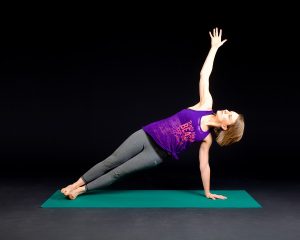
Try exercising for a few hours each week to get in shape and stay at a healthy weight
-
Dark Leafy Green Vegetables
Adding dark leafy green vegetables, like kale, spinach, and Brussels can help to prevent cataracts. This is because they contain high levels of lutein, which it can help to keep the eyes healthy. Take in more leafy green vegetables often to keep your eyes healthy.
-
Omega-3
Omega-3s are a type of naturally-occurring fatty acid that can help to keep the eyes healthy. There are various ways to take in more of this healthy fatty acid. Omega-3 supplements can be taken, or the fatty acid can be taken in my eating foods like fish, other seafood, seeds, and nuts.
-
Antioxidants
Antioxidants help to fight off free radicals. Free radicals attack the cells in the body. They can cause a variety of ailments, from a cold to cancer. Some foods that contain high levels of antioxidants include berries, fruits, vegetables, and nuts. Add more of these foods into your diet to protect yourself from free radicals.
-
Beta-Carotene
Beta-carotene is another ingredient found naturally in foods that can help to keep the eyes healthy and strong. Like omega-3, beta-carotene can be taken in through supplements or by eating certain foods. Some foods that are high in beta-carotene include squash, gourds, carrot, potatoes, dark leafy greens, cantaloupe, and stone fruit.
-
Selenium
Selenium is a naturally occurring mineral that also works to prevent cataracts. Like many of the other ingredients in this article, selenium can be taken in through supplements or by eating certain foods. Some foods that are rich in selenium include eggs, poultry, seeds, brown rice, meat, cheese, seafood, and lentils.

Brown rice is also rich in fiber
-
Vitamin C
Vitamin C is one of the most important vitamins for the human body to take in. This helpful little vitamin can help to both boosts the immune system and prevent cataracts. While there are vitamin C supplements available, it is extremely easy to find vitamin C from food sources. It can be found in most fruits! Citrus fruits, like oranges, lemons, and grapefruit, are especially high in vitamin C.
-
Vitamin E
Vitamin E is best known for being great for the hair, skin, and nails. While it is less famous for helping the eyes, it can still do wonders in helping to prevent cataracts. Vitamin E is a little harder to find in food than vitamin C, but it can be done. Some foods that contain vitamin E include avocado, seeds, nuts, and fish. Vitamin E supplements are also available for those who cannot get enough of this vitamin in their diet naturally.
-
Avoid Corticosteroid Medication
Medications are known to have side effects, and one of the possible side effects of medications that are corticosteroids are known to be able to raise the risk of cataracts. It is best to avoid these medications when possible. Some common corticosteroid medications include Celestone, Orapred, Prelone, Aristospan Intralesional, and Prednisone Intensol.
-
Turmeric
Turmeric is a great little spice that can help to ease all sorts of symptoms, including swelling. This is because it is naturally anti-inflammatory. To use this home remedy, all you need to do is add more of this spice into your diet. It is a great addition to soups, Mexican food, and Indian food.
-
Bilberry
Bilberry is a type of herb that is filled with antioxidants. As discussed earlier in this article, antioxidants are great at protecting the eye (and one’s vision) from free radicals. To use this home remedy, simply drink bilberry tea regularly.

The bilberry leaves are used for this home remedy
-
Ginger
Like turmeric, ginger is also an anti-inflammatory spice. Even though ginger and turmeric work, in the same way, to keep the eyes safe from cataracts, they are not used in the same way. Ginger can be added to meals, much in the same way turmeric can, but it can also be drunk as a tea. Adding ginger to your meals or drinking ginger tea daily can help to prevent cataracts.
-
Garlic
Garlic is another anti-inflammatory spice. Unlike ginger, it works in basically the same way as turmeric does. To use this home remedy, all you need to do it add more garlic into your diet. Try adding garlic to your meals more often. If you do not like the taste of garlic, try taking garlic supplements instead.
-
Zinc
People who do not have enough zinc in their system can be at a higher risk for cataracts than people who take in enough zinc. For this reason, it is best to take in more foods that are naturally rich in zinc. Some of these foods include nuts, seeds, legumes, eggs, whole grains, meat, seafood, and dairy products.
- Zeaxanthin
Zeaxanthin is a type of carotenoid that is used to keep the eyes strong. For this reason, it is best to take in as much of this as possible! Luckily, it is found in many foods, mostly vegetables. Some of these foods include carrots, dark leafy greens, pumpkins, peas, eggs, tomatoes, and oranges.
-
Low Salt Intake
Eating too many foods that are high in salt can hurt the eyes. This is because salt is inflammatory. To avoid eating too many salty foods, it is best to avoid fast food, junk food, and other processed foods. A person’s best bet is to simply make more meals at how out of fresh ingredients. Also, using seasonings, like herbs and spices, rather than salt can help to flavor food without adding more sodium to the meal.
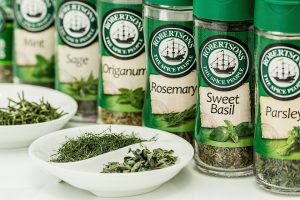
Use herbs and spices, rather than salt, to flavor your meals
-
Low Sugar Intake
Just like taking in too much salt, taking in too much sugar can also damage the eyes. The rules for avoiding sugar are much like that of avoiding salty foods: avoid fast food, junk food, and overly processed foods. It is also best to avoid sodas and juices, as they tend to contain high amounts of sugar.
-
Ginkgo Biloba
Ginkgo biloba is another food that helps to keep the eyes healthy. It does this by making it easier for the blood to flow in and around the eyes easier. There are many ways to use this home remedy. Some popular methods include drinking ginkgo biloba tea or taking supplements.
-
Stay Hydrated
Lastly, it is always important to stay hydrated. The human body is made mostly up of water. When there is a lot of water in the body, it can run more smoothly. The hydration levels of the body affect every part of the body, including the eyes. Try to drink eight glasses of water a day to stay hydrated and protect your eyes from cataracts.

Drink clean water to get the best results and to avoid disease
Which of these preventative measures will you take? Comment below!
References
https://www.mayoclinic.org/diseases-conditions/cataracts/symptoms-causes/syc-20353790
http://visionsource.com/blog/prevent-cataracts/
https://www.verywellhealth.com/preventing-cataracts-naturally-89270
https://www.allaboutvision.com/nutrition/cataracts.htm
https://irisvision.com/cataract-prevention-tips-to-prevent-cataracts-naturally/
https://www.webmd.com/a-to-z-guides/beta-carotene
https://www.medicinenet.com/corticosteroids-oral/article.htm
https://www.healthline.com/nutrition/best-foods-high-in-zinc
Cataract picture credit to Imrankabirhossain

